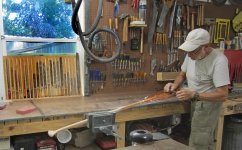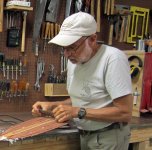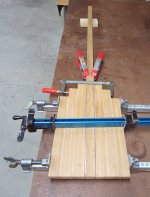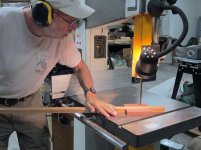-
Happy Birthday, Grace Kelly (1929-1982)! 🕛Ⓜ️🪟👑
You are using an out of date browser. It may not display this or other websites correctly.
You should upgrade or use an alternative browser.
You should upgrade or use an alternative browser.
Building Canoe Paddles
- Thread starter Marc Ornstein
- Start date
Interesting, your card file looks a lot like the ones I use for alpine and Nordic ski tuning.Using a card scraper to flatten and smooth the epoxy surface of a freestyle paddle. One of several steps before final finishing.
Probably a bit stiffer but otherwise, pretty much the same. Using the card scarper instead of sandpaper is faster, cleaner, much better at flattening the surface and also a lot more satisfying to use.
True, for ski base shaping the card file is really stiff. For removing fine hairs and smoothing and for wax removal the card files I use are fairly flexible.
Marc, thanks for taking the time to post a photo essay on how you make laminated wood paddles.
Do you have a standard menu of woods you use to make a paddle, or do you vary it depending on supply, customer request, whim, or other factors?
Soon to become a paddle. All parts cut. 17 pieces plus Dynel edging (not shown).
Do you have a standard menu of woods you use to make a paddle, or do you vary it depending on supply, customer request, whim, or other factors?
Nice shop Marc. I see that you make custom paddles, how does that work?
Western red cedar is the most common wood that I use for the blades and shaft core. I also use eastern white cedar, and occasionally some repurposed redwood that I have on hand. For ultra light blades (saves and ounce +) I use paulonia.Marc, thanks for taking the time to post a photo essay on how you make laminated wood paddles.
Do you have a standard menu of woods you use to make a paddle, or do you vary it depending on supply, customer request, whim, or other factors?
The shaft facings, blade tip, grip blocks and grip cheeks are hardwood. I use a lot of walnut but also hard maple, cherry and other woods. Often the choices are made by the customer but most leave that up to me.
I have a conversation with the customer to determine their need/want. We discuss the type of paddle (river, shallow water, freestyle...). Then comes a discussion of shaft length. Sometimes their is a special request about grip size and or paddle shaft diameter. Aesthetics are always discussed, which include what woods will be used. Is it going to be a "working" paddle or a "wall hanger". Weight may not be a consideration for a wall hanger. Although all of my paddles are such that they are suitable for display, one built specifically for display may warrant a higher grade of finish. Then there is time frame ......Nice shop Marc. I see that you make custom paddles, how does that work?
I really appreciate you sharing this. What kind of glue do you use, Marc?
Titebond III for most although a few parts are done with epoxy.I really appreciate you sharing this. What kind of glue do you use, Marc?
The cut out blade is shown in the foreground of the 1st photo. In the second photo the hardwood shaft facings and the grip cheeks have been glued and clamped. You'll note that the paddle is clamped to an extruded aluminum channel. This assures that there is no twist or warp in the shaft. When the shaft core was laminated,earlier, it was also clamped to the aluminum channel.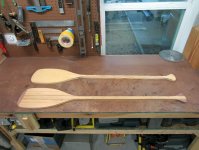



- Joined
- Aug 10, 2018
- Messages
- 1,984
- Reaction score
- 3,202
Are the shaft facings just for color variation; so that you can plane the blade & shaft center thinner and, therefore, save time on the blade, or both?
Also, what thickness did you plane to / how thick are the facings? (I do solid wood paddles but I do like the color variations of the laminates)
Also, what thickness did you plane to / how thick are the facings? (I do solid wood paddles but I do like the color variations of the laminates)
The hardwood shaft facings add stiffness. A cedar shaft alone would be too flexible. It, would also break too easily. When one paddles, the front and rear faces of the shaft are always being stressed. Sometimes the stresses are in compression, sometimes in tension. There are relatively small stresses on the inner core. Thus, the advantage of a light weight core, reinforced on the faces. It's definitely not a time saver. A single piece shaft would be quicker/simpler to make. The core is roughly 3/4 " thick and the faces roughly 1/4" each, prior to shaping. Additional benefits of a laminated shaft are that it will likely never warp and that a minor grain imperfection in any one laminate will have minimal effect on the overall strength of the shaft.Are the shaft facings just for color variation; so that you can plane the blade & shaft center thinner and, therefore, save time on the blade, or both?
Also, what thickness did you plane to / how thick are the facings? (I do solid wood paddles but I do like the color variations of the laminates)
As for aesthetics, there are the obvious opportunities to be creative with different wood colors, as long as one keeps in mind that function takes precedence. It does take considerable effort and time to make sure that everything stays symmetrical in appearance as one shapes the shaft and blade. The intersections of the various colored woods and the shapes formed as the shaft is rounded and the grip is carved must be kept precisely symmetrical, side to side and front to rear otherwise the paddle just won't look right. This will become apparent as I post additional photos of the shaped shaft, blade and grip.
And perhaps more importantly, just won't feel right. Do you also consider paddle balance when considering materials for grip and blade, aiming for a particular balance point?The intersections of the various colored woods and the shapes formed as the shaft is rounded and the grip is carved must be kept precisely symmetrical, side to side and front to rear otherwise the paddle just won't look right.
I should have been more diligent about that, years ago. As my dad used to say, "too old too soon, too smart too smart too late".Glad to see you wearing ear pro!
Yes. Balance is important. When the shaft hand is in it's "normal" position, 4-6" above the throat, the paddle should be slightly blade heavy, IMO. Years ago, I remember seeing some paddles that had been grip weighted with an ounce or so of lead so as to offset too much blade weight. Figuring out how to make a light and also strong blade seems a better way to go.And perhaps more importantly, just won't feel right. Do you also consider paddle balance when considering materials for grip and blade, aiming for a particular balance point?
Similar threads
- Replies
- 16
- Views
- 557
- Replies
- 9
- Views
- 754
- Replies
- 23
- Views
- 2K

